Magic Moments with Verb Circus
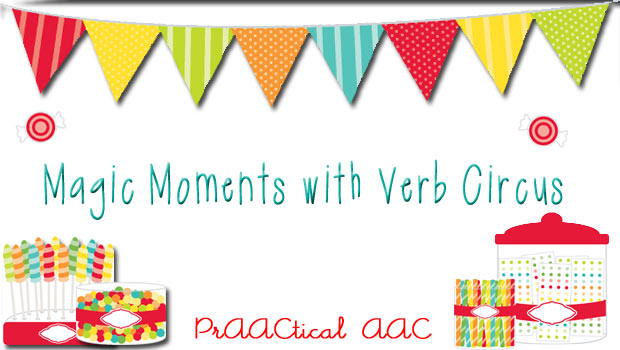
 We are so excited to see the expanded web presence by SLPs who are blogging, running groups on Facebook, sharing resources on Pinterest, and maintaining online stores on TeachersPayTeachers. We’ve been thinking about how to connect with some of these creative professionals, both to extend our own professional learning networks and also to broaden the reach of our AAC message. Recently, when an opportunity to forge a few connections presented itself, we decided to collaborate with a few new SLP friends.
We are so excited to see the expanded web presence by SLPs who are blogging, running groups on Facebook, sharing resources on Pinterest, and maintaining online stores on TeachersPayTeachers. We’ve been thinking about how to connect with some of these creative professionals, both to extend our own professional learning networks and also to broaden the reach of our AAC message. Recently, when an opportunity to forge a few connections presented itself, we decided to collaborate with a few new SLP friends.
Periodically, we will be featuring the materials of a fellow SLP who typically writes for colleagues serving primarily children with high incidence disabilities. They post great ideas and materials for students with articulation and phonological difficulties, fluency problems, and language disorders. We hope to put a prAACtical spin on their great ideas. In our inaugural post of this type, we hope to inspire some Magic Moments with fellow SLP Jocelyn Kupperman, who blogs at Ms. Jocelyn Speech. Today, we will take a look at her Verb Circus, which consists of a packet of themed material that can be used to provide practice on 50 regular and irregular verbs in simple present, present progressive, past, and future tenses. Data collection sheets are included.
Because Verb Circus was not developed specifically for an AAC audience, it uses clipart rather than AAC symbol sets/systems on the materials. The adorable clipart is theme-related and is not meant to depict the gloss (meaning) of the target words. For example, the 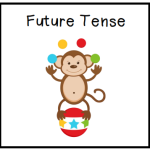 present tense verb cards all have circus tents, past tense cards all have clowns, and all the pronoun cards have popcorn. To make it meaningful to your AAC students, you can create a companion visual support with the verbs represented in their AAC symbols. Alternatively, you can add the AAC symbols for the target words onto the teaching materials. In any event, it makes sense to preview the verbs you will be targeting on the communicator’s AAC system before you begin any games or activities using these materials. Throughout the session, strive to have the learners use their individual AAC systems to practice the words they are learning.
present tense verb cards all have circus tents, past tense cards all have clowns, and all the pronoun cards have popcorn. To make it meaningful to your AAC students, you can create a companion visual support with the verbs represented in their AAC symbols. Alternatively, you can add the AAC symbols for the target words onto the teaching materials. In any event, it makes sense to preview the verbs you will be targeting on the communicator’s AAC system before you begin any games or activities using these materials. Throughout the session, strive to have the learners use their individual AAC systems to practice the words they are learning.
If you are writing goals for language skills that align with Common Core State Standards in language arts and want to provide circus-themed practice opportunities, you can certainly incorporate these materials. Here are some thoughts on how to use these them effectively with your AAC learners.
General Intervention Guidelines
Determine which verb patterns to target: Regular or irregular past tense? Present, present progressive, past, future tense? Main verbs or auxiliaries? With more proficient language users, you can mix things up a bit but if the AAC user is still learning verb forms then you’ll want to set it up so that the patterns are apparent. Some high tech SGDs assist with selecting the correct verb tense based on the sentence context, but learners still need to understand the concepts behind different verb conjugations and tenses. Note: If you do mix the tense patterns, you may want to alter the verb cards so that the present tense verbs begin with a lowercase letter and match the other tenses. We know how perceptive some learners are, particularly those with ASD. (Some kids are likely to think that all present tense verbs start with a capital letter while past tense verbs start with lowercase letters.)
Select the focus words: For students still learning their AAC systems, it makes sense to select a portion from the word lists provided. We think it is better to have success with a smaller number of words than to struggle with the full lists. Also, some of the verbs in the word lists do double duty, which is a great thing to talk about with more proficient language users. However, you may want to steer clear of verbs that can also be nouns (e.g., itch) if it will confuse your learners.
Begin with a warm-up: Although these are words you’ve already taught, it makes sense to refresh that learning with a quick preview. Look through and talk about the word cards, taking time to find and say the words using the AAC system. In a perfect world, it would be great to have the AAC learner say each of these words using their main communication device but it may take too much time and effort to do this with all words. Use your judgement.
Review the pattern: Revisit your original explanation of the verb tense patterns (e.g., “In this game we’re going to think about how time changes our action words. Let’s talk about how we make an action word fit for something that happened yesterday. What part of the word do we usually change?” etc.). Reviewing those rules helps solidify their understanding and sets the stage for informative or corrective feedback that you will be using later in the activity.
Determine how you want to use the materials: A drill and practice approach (e.g., show a card and have them say the verb in a sentence) works for some children. Others need us to embed the practice in a meaningful context, such as acting out the verbs with action figures or favorite book characters. Another option is to embed the practice into a motivating activity, like bean bag tosses or shooting a foam basketball (e.g., say the word/sentence before throwing). As with all your therapy activities, these decisions get made based on the learner’s unique profile.
Use assistive technology: Using an All Turn It Spinner, a Literacy Cube, or some other adaptation may give the learners more opportunities to be active in the game, reduce their frustration, and make the game more fun.
Use visual supports: We’re big advocates of using these with many types of learners, but particularly those who have significant limitations in their oral language comprehension. Supports to consider: picture schedules for the session, mini-schedule for this activity, first/then board, countdown board, communication board for aided language input, color-coded template for sentence building.
Implementation Ideas
Morphology: Many of our AAC learners need added experiences in changing word forms. If you are teaching a specific morphological structure, such as word endings for regular past tense, you can use this set of materials to help give the learner massed practice in applying that concept. You’ll have to pre-teach the concept, (i.e., what the word ending is, what it means, how to say it with their AAC systems, and how it’s written). Then, you can use this kit to provide a ton of fun practice opportunities. Remember to use informative feedback when the learner responds so that they gain an even deeper grasp on the concept.

Core vocabulary practice: For learners who like games and can benefit from decontextualized language practice, the sentence building activity offers some prAACtical opportunities to practice pronouns, core verbs (e.g., help, talk, think), conjunctions, prepositions, and determiners. We love giving kids lots of practice with a variety of materials.
Sentence Structure: Many of us work with kids who are learning to create specific declarative or interrogative sentence forms, something that takes practice and lots of repetition with variety. The Circus Verb materials could certainly play a role in having children practice new sentence types. The kit comes with dice for subject pronouns and verb tenses. Pick whichever one is most relevant for your learner and develop a game so that they can create sentences with their target verbs. We appreciate the Sentence Organizer that comes with the kit, but if your learners use color coding in their AAC systems (e.g., modified Fitzgerald Key), you may want to adapt this to be consistent with their SGDs or other communication tools. That way, they can learn the sentence building pattern.
Pragmatics: Playing games is not something that comes naturally or easily to many kids with significant communication difficulties. They need structured opportunities to learn and use appropriate pragmatic skills when playing games with rules. If you’re also working on verbs with students who need support to learn to play games, the Circus Verbs cards can be used in place of the regular game materials. Remember to make the game process/rules visible. Visual supports that depict what will happen in the game are not optional for this population. They are a standard of care that helps the child better understand the expectations.
Syntax (Verb Phrase Development): Creating sentences with main verbs is a good start, but to approximate age appropriate language we must teach verb phrases. Circus Verbs includes 6 helping verbs, so you can practice phrases that include these auxiliaries: is, are, was, were, has, have.
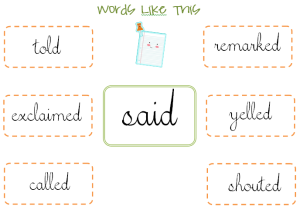
Semantics: These materials can also be used to address Tier 2 vocabulary words, which is an appropriate goal for many learners who have gone beyond the Beginning Communicator level. Think about using the words in this kit as samples and coming up with alternatives to build lexical diversity. For example, you and the children can talk about vivid verbs and create a list of alternatives to words like ‘walk’ or ‘talk.’ Use your own semantic webs (like my example here) to map out relationships or come up with concepts related to words like ‘fight’ or ‘grow.’
Final Thoughts
A few months back, we introduced a planned sequence of robust vocabulary instruction. These materials are well-suited to practicing words that you have taught through Focused Language Stimulation and Explicit Instruction that we discussed in that model. You can use them to create multiple opportunities for your AAC Learners to say these words alone and in sentences. Remember to continue using aided language input as you say these words. Creative SLPs will have a great time using these thematic materials, particularly if you are doing a circus theme in the classroom.
Choosing materials is an important part of the therapy planning process. Many thanks to Jocelyn Kupperman for reaching out and for sharing her materials. Hope you have some prAACtical fun with the Verb Circus Packet.
Filed under: PrAACtical Thinking
Tagged With: Magic Moments, therapy materials, Verb Circus, verbs
This post was written by Carole Zangari

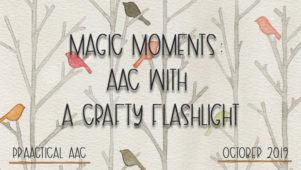
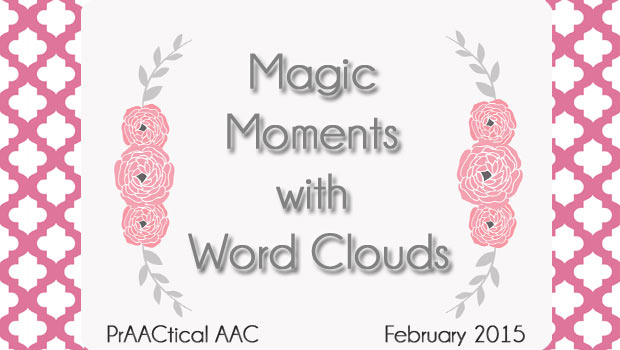

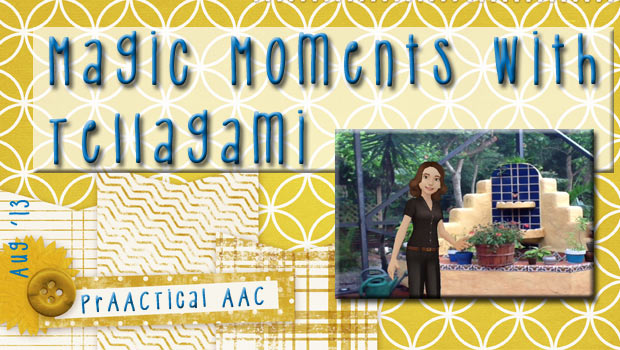
1 Comment